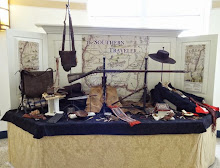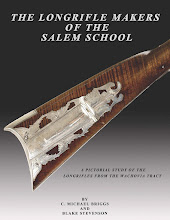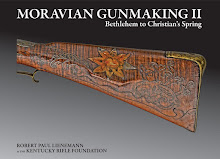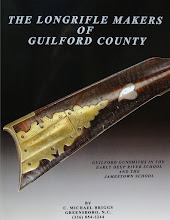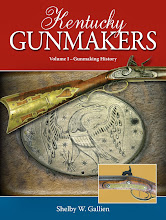Johannes Rupp of Macungie
(A preliminary study, to be updated as necessary)
Part III
The first solid record I can find for John Rupp is in the records of the men who took the Oath of Allegiance (act passed in June 13, 1777) in Northampton County. John did not take the Oath until 1783 before Justice Peter Trexler (Marx room records, Easton Public Library), however Herman and Andrew had already taken it (also before Peter Trexler) together on November 1, 1779. Once the act was passed as a provision of the militia law, all males above 18 years were compelled to take the Oath before the following July (1778) although there seems to have been a bit of leeway given the hectic activities in Pennsylvania during this period and availability of Justices. That John managed to go until April 26, 1783 without taking this oath does reinforce the belief that he was younger than the other brothers and indicates that he had not yet ‘come of age’ at the time the act was passed. I can’t find a reference to either Jr. or Sr. George Rupp taking the Oath, however they may have taken it before another official whose lists have not yet come to light - to my knowledge, only approximately half of the Justices’ lists have survived relative to the number who were sworn in for Northampton County. The Act was passed as part of the updated militia law, and George Sr. was likely (assuming his birthdate was somewhere approximating 1721) too old for militia service anyway, so I’m not clear on whether he would have been expected to swear the Oath. By June 16 of 1784, John Rupp is listed as a Private of the 5th class in Captain Jacob Grim’s company of the 3rd Battalion of Northampton County militia under Colonel Peter Trexler (so possibly mustering in 1783 when he took the Oath). George Jr. and Andrew were also listed in this company at that time, George being of the 3rd class and Andrew being of the 8th class (PA Archives 5th series). Earlier, in the winter of 1781-1782, George Rup and ‘Andres’ Rup were found in “A Gen’l Return Of The 1st Battalion of Northampt’n County Militia Comand’d by Steph’n Balliet Esq’r Lieut’t Coll. 1st Nov. 1781-1st Jan’y 1782.” They were listed in the 6th Company under Captain John Trexler (PA Archives 5th series). John Rupp is not found in this muster roll. As a brief side note, these “class” groupings do not appear to have had relation to rank or status; this appears to have been a rotational grouping method to ensure that once called to muster or otherwise called into service, an individual could be assured that he would not be immediately called back into service once his allotted time had concluded.
During this 1783-1784 period, I am unaware of any other record of John. A surviving 1785 tax assessment for Macungie (PA Archives 3rd series) notes Herman Rupp with 260 acres, 4 horses and 4 cattle, Andrew Rupp with 100 acres, 1 horse and 2 cows, and George Rupp (Jr.) listed with the single men. However, no John is to be found. Later, in 1788, another assessment lists Herman and Andrew with the same land and livestock, but George is missing and John has yet to appear. Finally, in a 1790 list of taxables (no assessed values given), John Rupp and George Rupp are both listed as single freemen (LCHS). It is unclear to me whether or not a man who had passed the age of 18, but was still living with either a parent or other family member, would be included on an assessment list, or if the lists essentially enumerate the ’head of household’ (to use a modern term) only.
Jumping back a year to 1789, in the records of the Trexlertown Union congregation, “Johannes Rupp” was sponsor to Johannes, son of Andreas Rupp and wife Maria on May 24. He (Johannes Rupp) is noted as being single. Almost a year later, on March 12, 1790, “Johannes Rupp” was again sponsor to another Johannes, this time a son of Conrad Meitzler and wife Anna Margaretha (probably one of his sisters). Once more, Johannes Rupp is noted as single. (Trexlertown Union records).
On October 8, 1790, John Rupp was witness to a bond transaction or indenture in Macungie township between Jacob Albright, John Albright and Jeremiah Trexler (NH Co. Deed book G1) and then exactly one year later, on October 8, 1791, Johannes Rup was sponsor at the baptism of yet another nephew Johannes, this time recorded with the Jordan Reformed congregation and a son of brother “J George Rup” and wife Catharina. There is no notation of “single” so Johannes was most likely married at that point. To close out the year of 1791, on December 7 John Rupp was witness to a property transaction in Macungie township between Jeremiah Trexler and William Hains (NH Co. Deed book H1).
Jumping forward, we find the first ‘Direct Tax’ of 1798. Fortunately, Ancestry.com can play a legitimate role here as it supplies not merely transcribed abstracts but actual, verifiable microfilm images for Northampton County. These records are detailed and there are multiple lists of what appear to be multiple nitpicking assessments. I am not going to pretend to fully understand how it all worked so I’m merely going to illustrate what I was able to find. Let’s have a round of applause for bureaucracy!
The first assessment states, “General list of Lands, Lots, Buildings and Wharves, owned, possessed or occupied, on the fifth Day of October, 1798, within the Township of Macungie in the second Assessment District of the fifth Division of the State of Pennsylvania excepting only such Dwelling-Houses as, with the Out-Houses appurtenant thereto, and the Lots on which they are erected, not exceeding two Acres in any Case, are above the Value of One Hundred Dollars.” Under “Dwelling-Houses and Out-Houses of a Value not exceeding One Hundred Dollars,” Herman Rupp is shown with one and John is shown with none. Under “Lands, Lots, & c. subject to and included in the Valuation,” both Herman and John are shown with 140 acres.
The next list states, “General List of all Dwelling-Houses which, with the Out-Houses appurtenant thereto, and the Lots on which the same are erected, not exceeding two Acres in any case, were owned, possessed or occupied not he first Day of October, 1798 within the Second Assessment District of the fifth Division in the State of Pennsylvania exceeding in Value the Sum of One Hundred Dollars.” Herman is listed with 1 dwelling house, 1 out house. John is listed with 1 dwelling house. Under the heading “Quantities of land in the lots valued therewith,” both men are listed as 1 acre, 80 perches. “Valuation as determined by the Principal Assessors” puts them both at 200, and then “Valuation as revised and equalized by the Commissioners” lists both at 250.
Next up we find “A Particular List or Description of all Lands, Lots, Buildings and Wharves, owned, possessed or occupied, on the fifth Day of October, 1798 in Macungie Township Northampton County being within the second Assessment District of the 5th Division in the State of Pennsylvania excepting only such Dwelling-Houses as, with the Out-Houses appurtenant thereto, and the Lots on which they are erected, not exceeding two Acres in any Case, are above the Value of One Hundred Dollars.” Under “Dwelling-Houses and Out-Houses of a value not exceeding 100 Dollars” we again see Herman with 1 dwelling house, $60, while John has none. Then, “Number and Description of all other Buildings and Wharves” shows Herman with “1 old log Barn” and John with “1 log Barn unfinished.” Finally, “Quantities of Land and Lots admitted to be subject to Valuation” show 140 acres for each man.
There is one more document showing “Particular List or Description of each Dwelling House owned, possessed or occupied, on the fifth Day of October, 1798 in Macungie Township Northampton County being within the second Assessment District of the 5th Division in the State of Pennsylvania.” This shows John with 1 Dwelling House and Herman with 1 Dwelling House. Under “Outhouses appurtenant,” Herman is recorded with “1 adjoining piece.” Under “Dimensions of Area,” Herman is marked 28 by 25 and John 27 by 20, and under “Materials of which built” John is marked “Log” and Herman “ditto, old.” “Number of stories” for both structures is marked as 2.
Just to close out this stupendously massive assessment (it did instigate the Fries Rebellion, after all!), we find Andrew Rupp listed as living in a dwelling owned by John Lichtenwalter with a Barn measuring 40 by 26 and on 154 acres of land. I am not going to dig into this one any further as Andrew was not a gunsmith and I’m tired. I don’t know where George was located at this point but hopefully it was far away from these exceptionally nosy assessors.
Part IV
Briefly looking at what census records are available (direct images via Ancestry.com, once again), Andrew “Roop” and George “Roop” are both found in “Macunge” in 1790. This census was not particularly detailed and females were not assigned ranges of age at all, while males were only broken down to under 16 years or 16 years of age and over. Where was Herman? I don’t know. John is also missing. Andrew is shown with a household of 4: one male under 16, one over 16 (himself) and two females (wife and daughter, one would assume.). George is shown with a household of 3: one female, and two males over 16. Now this creates an interesting question: which George is this? George Jr. was married sometime between 1785 (aforementioned tax list, still with the single men) and 1791 when his son Johannes was born (baptism also aforementioned). Looking at the 1790 census from the perspective of either George Sr. or Jr., we can assume one of the males over 16 was George Rupp and the female was his wife, but then who was the other male over 16 in the household? If this George Rupp represents George Jr., his son Johannes (aforementioned) was not born until 1791.
For the year 1800, the “Maccongie” census is thankfully a bit more detailed. John Rupp, the focus here despite my incessant wandering, is listed for Macungie township and has a total household of 4. There is one person over 25 years of age (I assume John), 1 female between 16-25 (I assume his wife), 1 male 10 to 15 years old and 1 female under 10. Meanwhile, just to wander away from John again for a moment, Herman, George and Andrew are all listed as well although now Andrew has moved up to “Weissenberg” township. One item of interest, which I can not currently explain, is that the listing for Herman indicates 1 male over 45 years of age and 1 female 26-45 years of age along with 3 other younger folks. If Herman was actually born in 1756, it would be expected that he would be slightly under 45 years of age in 1800. This seems to indicate that his ‘accepted’ birth date may be off by a year or so, or perhaps he himself was not entirely aware of his exact birth date (which was not uncommon). Alternately, perhaps the census recorder was an idiot. Another item of interest is that the listing for George Rupp indicates a household of only 2, and both individuals (1 male, 1 female) are over the age of 45. This probably is George Sr., for as I illustrated above at least one child was baptized to J. George Rupp in 1791, so unless the child died and George Jr. and wife had no other children, it could only be George Sr. Virtually every online source puts Ursula’s death in 1800, though without documentation, so possibly the census was taken before her death that same year. This is not completely clear but if this is George Sr., then George Jr. has now disappeared.
A number of years ago, I was provided with an interesting transcription of a document involving John Rupp. Dated 1802, there is an indenture extant for “…John Rupp of Maccongie township in the County of Northampton and the State of Pennsylvania Yeoman… and his wife Margaret…” in which John sold to Jacob Shoemaker 40 1/4 acres for 200 pounds. The deed further notes the land borders a parcel “…intended to be granted to Herman Rupp…” and it appears that the 40 acres being sold was originally part of a larger portion (83 acres of it is mentioned as part of a patent) which was sold to George Rupp in 1774, and in 1797 George and wife Ursula either sold or granted “…with one other piece of land the above described forty acres and a quarter unto their son the said John Rupp (party hereto) in fee.” This document seems to indicate that while he was still present in Macungie township, he was selling and/or disposing of land. This might indicate he had moved or was preparing to move. Also interesting is that we finally get a documented name for his wife, “Margaret,” and that there is the mention of land that is to be granted to brother Herman. Who was doing the granting? And why “Yeoman?” Was he no longer gunsmithing? I do not have an original copy of this document, but I am currently attempting to track down a copy for verification.
Within the 1810 Federal Census for Macungie, “Harman Rupe” is listed and up in “Wisenberg” township (bordering Macungie to the NW), “Andrew Rup” is listed. John is absent as is George Jr. Herman and wife are both 45 yrs or older, while other household members include a male and female b/t 16-25 and two females under 10; it seems quite likely that these others represent Herman’s son Jacob and his young family.
In the 1820 Federal Census for Macungie - now Lehigh County (formed 1812) - there is in fact a John Rupp present, however this is clearly the son of either George Jr. or Andrew (somewhat unclear, as both men baptized sons “Johannes” within two years of each other, 1789 and 1791) who was also a noted 19th century gunsmith. This John Rupp had three children under 10 represented in the record.
Going any further with the census records is really of more interest to Rupp family genealogists, for by the next decade there were Rupps of this family group all over Northampton and Lehigh counties. Actually, casting a wider net, there were Rupps of various unrelated family groups all over Pennsylvania! Genealogy is not the focus of my investigation, as I have been primarily investigating Johannes Rupp the elder and as I will conclude below, there is certainly no need to pursue him any further than the decade 1810-1820.
The full articles can be found here. We will published more parts daily.




























































